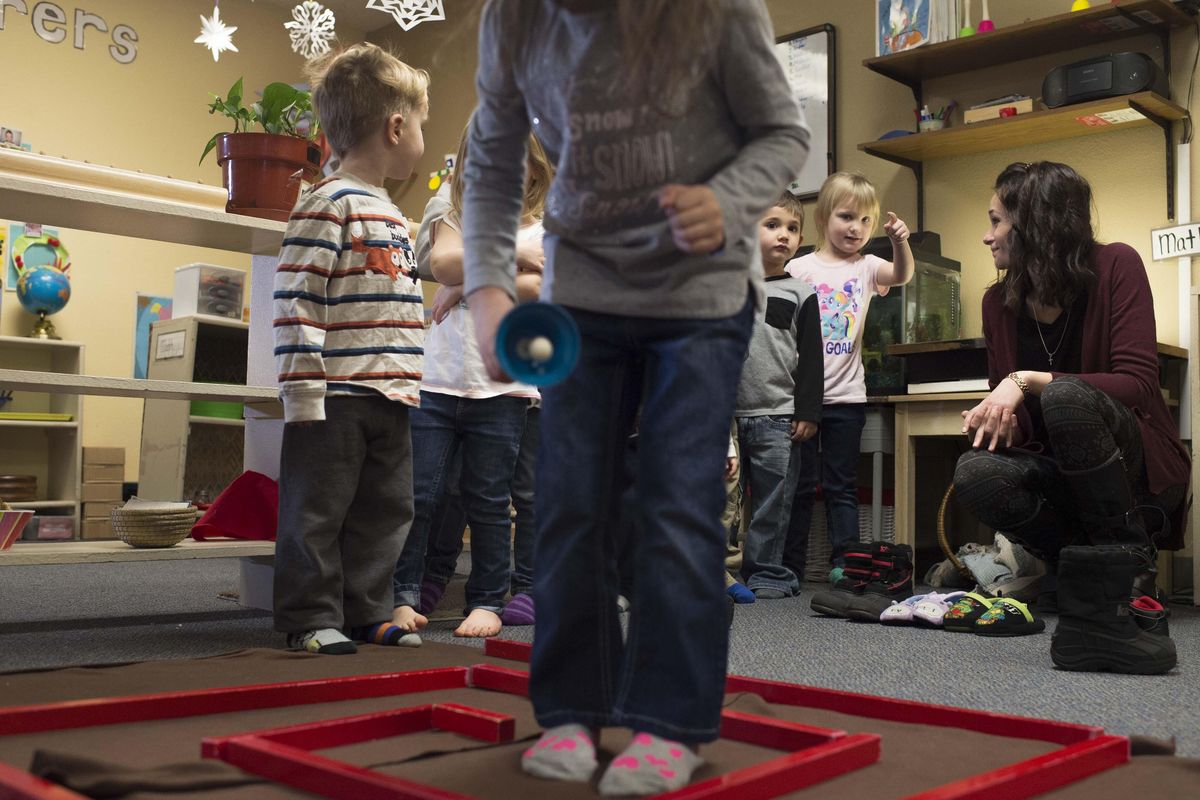Employers say higher state minimum wage hard on child care, food service, nonprofits

About 700,000 of Washington’s lowest-paid workers got a raise this week when the state’s minimum wage increased to $11 per hour.
At Children’s Montessori Center in Spokane Valley, that means bigger paychecks for some staff members, but also higher monthly rates for families enrolled at the child care center.
The new minimum wage is a quandary for Debbie Henry, who’s owned the Montessori center for 20 years, and other small business owners. They’re supportive of higher wages for workers but say they’ll have to pass the additional labor costs on to customers to stay in business.
“It’s going to have a big impact on our families,” Henry said of the higher wage. “Our accountants are telling us to raise rates. … The hardest part for us is to go to families and say, ‘Your child care is going up by $140 to $150 per month.’ ”
Raising Washington’s minimum wage from $9.47 an hour had strong support in November’s general election, passing with nearly 60 percent of the vote. Initiative 1433’s passage puts the minimum wage on a path to reach $13.50 by 2020.
For the state’s lowest-paid workers, the new wage will immediately boost regular, full-time earnings by about 15 percent, or $245 per month. That’s money that theoretically should make it easier for low-wage families to afford rent and put food on the table.
“Minimum wage doesn’t mean teenagers living at home with no expenses,” said Matthew Carroll, a 39-year-old delivery driver and father of three from Spokane. He earned $10.50 an hour before the new minimum wage took effect Sunday.
The city has plenty of low-wage workers who struggle to provide for their families, said Carroll, the breadwinner while his wife attends community college.
“Spokane is known as the $10-per-hour city,” he said.
But some employers are wrestling with the rapid increase in labor costs. With less than two months between the passage of Initiative 1433 and the Jan. 1 effective date, they say they had little time to prepare for the wage hike.
The economic impact “is probably more complicated than the average voter gave it credit for,” said Mark Starr, the owner of David’s Pizza in Spokane.
Many of his workers already earn $11 an hour, but he’s hearing from restaurant suppliers whose prices are going up as a result of the wage increase. The initiative also requires most employers to provide paid sick leave for employees by 2018, with a paid-leave accrual that’s more generous than the city of Spokane’s new sick-leave mandate for employers, Starr noted.
Both costs will add thousands of dollars to Starr’s monthly operating expenses. And restaurants, in general, operate on narrow profit margins in the 3 to 7 percent range, he said.
“I’m happy for the minimum wage worker, for that person who will be earning more money,” Starr said. However, “it is my sincere hope that the public understands that with this, prices will be going up.”
When it comes to eating out, “Spokane is quite frugal,” he added. “Prices are quite competitive, so they don’t give you a lot of room to raise prices.”
At child care centers, employers must comply with state licensing requirements for staffing levels, which dictates labor costs, day care owners said.
For centers accepting families who receive state subsidies for child care, there’s an added complication, said Henry, the Children’s Montessori Center owner. The state’s reimbursement rates don’t cover the cost of paying staff members $11 an hour, she said.
About 60 percent of Henry’s clients receive state subsidies. With low state reimbursement rates, she and other child care providers say they’ve been forced to raise rates for private-pay families.
At Children’s Montessori, rates for private-pay families are going up by about 30 percent. At Parkview Early Learning Center in Spokane, rates have risen by about 15 percent, co-owner Luc Jasmin said.
“I’ve had to jack up my prices to $750 for a child per month,” which applies to children ages 3 to 5, Jasmin said.
Families with more than one child in a state-licensed day care, or who have an infant, are paying more than $1,000 per month in child care costs, which is difficult on most incomes, he said.
“It’s tough,” he said. “You want to do a service for families … but I have a staff I have to pay.”
Jasmin, Henry and other child care providers plan to lobby this year’s Legislature for higher reimbursement rates. But even if legislators approve higher rates, they probably wouldn’t take effect until next summer, Henry said.
Washington’s Department of Early Learning is aware of the financial pressure the higher minimum wage is having on child care centers that accept subsidies, and is working on a financial analysis to share with the Legislature, said Stephanie Liden, a department spokeswoman.
Aside from businesses, Washington’s higher minimum wage will affect nonprofits that provide job training, such as Goodwill Industries of the Inland Northwest.
Goodwill trained 379 people last year in Eastern Washington and North Idaho, helping them develop job skills that increased their chances of getting hired by other employers, said Clark Brekke, Goodwill’s chief executive. Clients are paid minimum wage during the training, which usually lasts three to six months.
The organization will train fewer people this year, primarily as a result of Washington’s higher minimum wage. The decrease works out to a 19 percent reduction in job training, Brekke said.
“Frankly, we’re on both sides of the coin,” he said. “We’re interested in seeing people increase their ability to support themselves with family-wage jobs. On the other hand, it’s had a tremendous impact on nonprofits near and far.”